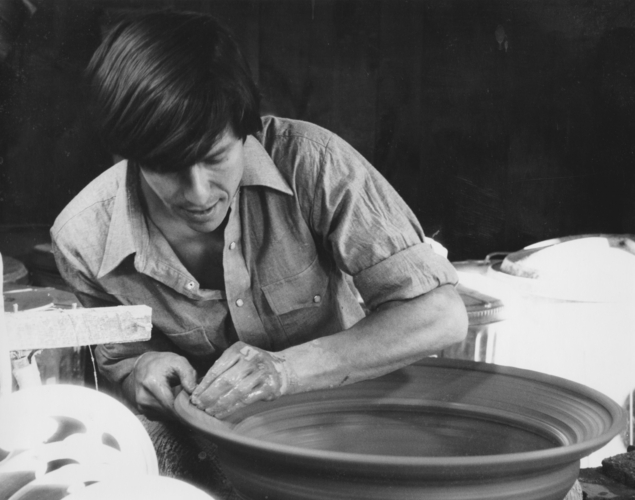PUTNEY — The 45th annual Putney Craft Tour features glass blowers, potters, jewelers, woodworkers, painters, and artisan cheese and wine makers in their studios.
"Every year, the tour draws arts lovers, shoppers and the curious," Ken Pick, one of the founders of the tour, said in a news release. This year, there are 21 working studios open to visitors on tour, which takes place 10 a.m. to 5 p.m., Friday, Nov. 24, through Sunday, Nov. 26.
The Putney Craft Tour began in 1978 in a meeting around the dining room table of organizer and woodcut printer, Margot Torrey. Putney's tour helped lead the way to a national movement of craft tours developing around the United States. Forty-five years later, the tour is still going strong with some of the original members and generations of artists who have followed them.
In its history, the tour has had more than 125 participating artisans. Some participated for a year or two and others for 10 years or more. For two of the founding members - Pick and glassblower Bob Burch - this will be the 45th year that they have shown the public their studios where they create their unique pieces.
There are always new members on the tour, new studios to see, new demonstrations of craft to educate and entertain, and new insights into the creative process in addition to the familiar favorites.
Silver jeweler Jeanne Bennett, who has been on the tour for 10 years, appreciates the feedback she gets from visitors.
"It's nice to get the work out in public. I'm up in the woods [in Westminster West], and I love hearing everyone's feedback," said Bennett. Like most of the artists, she has customers who return "to see what's new and add to their collection. More than anything, the tour is great entertainment. Driving through the Vermont countryside and finding the studios is an adventure in itself."
"Not everyone knows what they are getting into when they walk into a studio, as there can often be an element of surprise," says Pick, whose studio and gallery are in an old tobacco barn surrounded by gardens and fields as well as a 200-year-old maple. Sculptures and ceramic benches grace the garden, and large, colorful platters are showcased inside and out.
"The craft tour has helped put Putney on the map with hundreds of visitors moving through the studios over the course of the three days and engaging with the artists -the real draw of such tours," Burch says. For him, the tour is a family affair with daughter Caitlin, a jewelry maker, and son Ryan, who makes functional ceramics, joining the tour.
"I always ask people if it's their first time if I don't recognize them," says landscape painter Judy Hawkins. "I try to touch base with every person who comes in. I find people love to have a conversation. It opens their eyes to my work. Sometimes people stay in the studio for an hour; it's not just in and out."
For Hawkins, the bond that develops between the craftspeople and the visitors is what makes the Putney Craft Tour so meaningful.
Another early tour member: the Green Mountain Spinnery, chiefly engaged in machine spinning and dyeing of yarn from New England fleece, also - since its founding as a cooperative in 1981 - markets sweater patterns designed by Putney artists to go with their array of many-colored yarns.
Craftspeople in Putney have worked with the schools, offered workshops to children, and have taken on apprentices. For the last several years, The Putney Craft Tour has partnered with Sandglass Theater to offer performances during the tour. The craft tour also supports the Putney Food Shelf by offering items for sale in their studios to benefit the food shelf.
A little background
The artists had been in and around Putney, drawn into its creative orbit in the late 1960s and early 1970s for many reasons, including the back-to-the-land movement, the rise of American craft, and the powerful cluster of creative souls brought there by Windham College, the Yellow Barn Music Festival, The Putney School, and the Experiment in International Living. Some of those artists went on to start the Putney Craft Tour.
Although the tour was begun as a hospitable commercial venture, many of the craftspeople who joined felt that in celebrating the process by demonstrating how the work was made, in the setting where it happens, they would give the public not just interesting entertainment, but a new respect for the value of the finished product.
It was this aesthetic and educational aspect as much as the commercial one that provided the stimulus to keep it going. Torrey's persistent organizing called together the current resident independent craftspeople each spring to form a group and do it once again.
Sharing the many tasks involved, they produced the tour of crafts studios in Putney that eventually became such a very successful enterprise and was so enjoyed by participants from far and wide, that it became a model for the Vermont Crafts Council and many other communities in Vermont and elsewhere.
Well-marked signs and tour maps show the way for visitors. Folks can start at the Putney Mountain Winery & Spirits welcome center where they will find an exhibition of the artisans' work. Visit putneycrafts.com for more information about the artists, download the map, and sign up for the Craft Tour newsletter.
This Special section item was submitted to The Commons.
